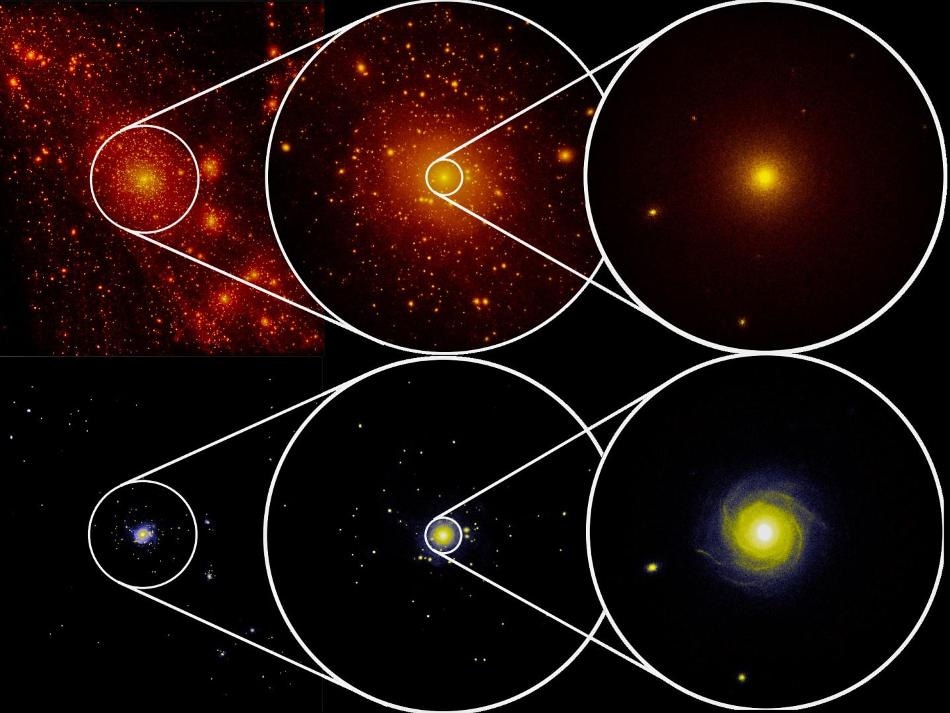Jun 26 2018
 Dark Matter" />This picture shows the distribution of dark matter (above) and stars (below). (Image credit: E. Garaldi, C. Porciani, E. Romano-Díaz/University of Bonn for the ZOMG Collaboration)
Dark Matter" />This picture shows the distribution of dark matter (above) and stars (below). (Image credit: E. Garaldi, C. Porciani, E. Romano-Díaz/University of Bonn for the ZOMG Collaboration)
Scientists from the University of Bonn and the University of California at Irvine used advanced computer simulations to develop a test that might solve a hot puzzle in astrophysics: does dark matter really exist? Or is there a need for Newton’s gravitational law to be modified? The innovative research, which has now been reported in the Physical Review Letters, demonstrates that the solution is hidden in the motion of the stars inside small satellite galaxies spinning around the Milky Way.
The researchers used one of the fastest supercomputers across the globe to simulate the distribution of matter in the so-called satellite “dwarf” galaxies. These are small galaxies that encircle, for example, Andromeda or the Milky Way.
The team paid attention to a relationship known as “radial acceleration relation” (RAR). Stars in the disk galaxies travel in circular orbits surrounding the galactic center. The acceleration that drives them to continuously change direction is brought about by the attraction of matter in the galaxy. The RAR describes only the link between this acceleration and the one brought about by the visible matter. It offers an understanding of the structure of galaxies and the distribution of matter in them.
We have now simulated, for the first time, the RAR of dwarf galaxies on the assumption that dark matter exists. It turned out that they behave as scaled-down versions of larger galaxies.” However, what no dark matter exists and rather gravity “works” contrary to Newton’s hypotheses? “In this case the RAR of dwarf galaxies depends strongly on the distance to their parent galaxy, while this does not happen if dark matter exists.
Professor Dr Cristiano Porciani, Argelander Institute for Astronomy, University of Bonn
This difference renders the satellites to be a robust probe for investigating whether dark matter really exists. The Gaia spacecraft, launched by the European Space Agency (ESA) in 2013, was already able to provide an answer. It was developed to investigate the stars in the Milky Way and its satellite galaxies in unmatched detail and has gathered a huge amount of data.
Yet, many years would have passed before this puzzle is solved.
Individual measurements are not enough to test the small differences we have found in our simulations. But repeatedly taking a close look at the same stars improves the measurements every time. Sooner or later it should be possible to determine whether the dwarf galaxies behave like in a universe with dark matter—or not.
Enrico Garaldi, Doctoral Student, Argelander Institute for Astronomy, University of Bonn
The Cement That Holds Galaxies Together
This question is one of the most critical issues in the field of cosmology at present. The presence of dark matter was already proposed over eight decades by Fritz Zwicky, a Swiss astronomer. He realized that the movement of galaxies within galaxy clusters is so fast that they should drift apart in reality. Hence, he proposed the existence of invisible matter which, because of its mass, exerts adequate gravity to retain the galaxies on their observed orbits. In the 1970s, Vera Rubin, Zwicky’s US colleague, found out a similar phenomenon in spiral galaxies such as the Milky Way—their rotation is so fast that the centrifugal force should actually rip them apart in case only visible matter existed.
At present, the majority of physicists are certain that dark matter constitutes nearly 80% of the mass in the universe. As it does not interact with light, it cannot be observed using telescopes. However, presuming that it exists offers an exceptional fit to a number of other observations—such as the background radiation distribution, which is an afterglow of the Big Bang. Dark matter also offers a better interpretation of the arrangement and rate of formation of galaxies in the universe. Yet, in spite of a number of experimental attempts, there has been no direct proof for the existence of dark matter. This resulted in astronomers hypothesizing that the gravitational force itself could act differently than it was thought earlier. The so-called MOND theory (MOdified Newtonian Dynamics) suggests that the attraction between two masses complies with Newton’s laws only up to a specific point. At very small accelerations, for instance, those that prevail in galaxies, gravity turns out to be much stronger. Hence, galaxies do not get ripped apart as a result of their rotational speed, and the MOND theory can dispense with the obscure star putty.
The innovative study makes it probable for astronomers to investigate these two hypotheses in an unparalleled regime.
The German Research Foundation (DFG) funded the study through TR333 and SFB956. The calculations could be made with assistance from the Europe-wide PRACE network and were performed on the Dutch supercomputer Cartesius, at SURFsara, The Netherlands.